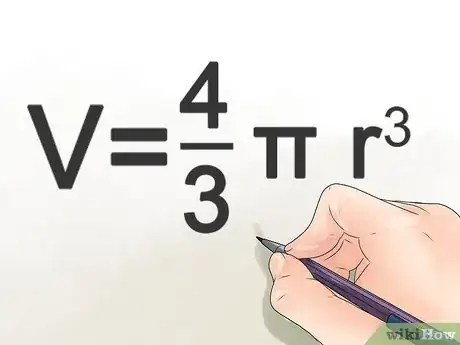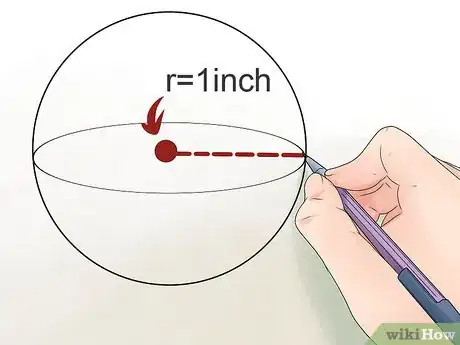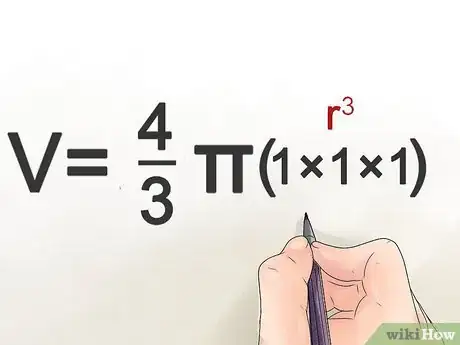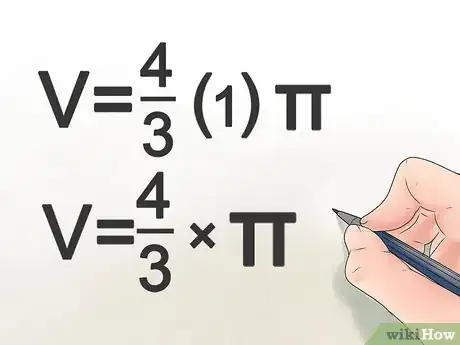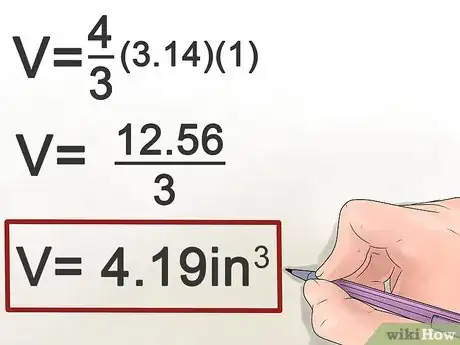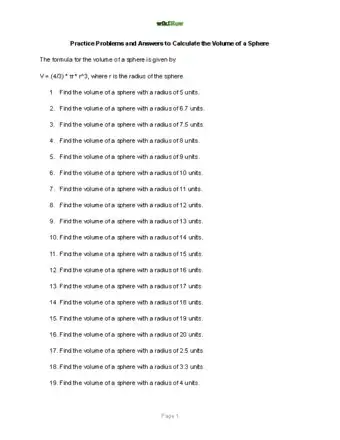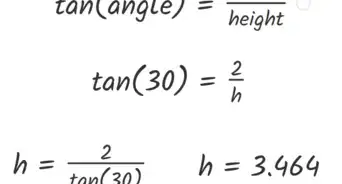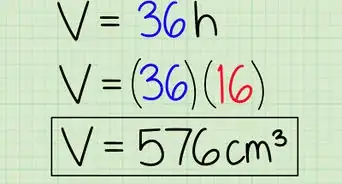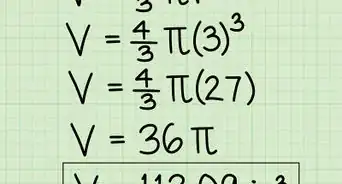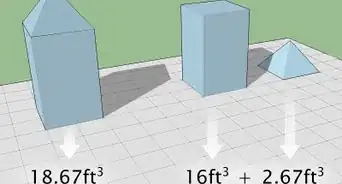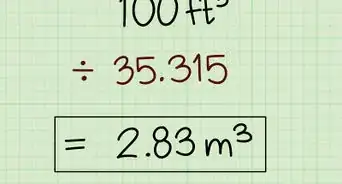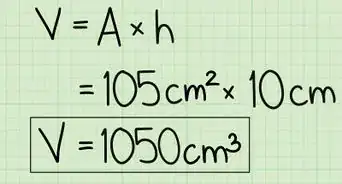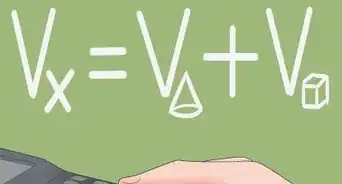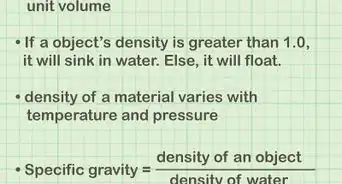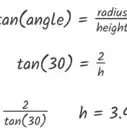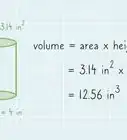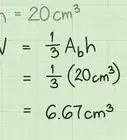wikiHow is a “wiki,” similar to Wikipedia, which means that many of our articles are co-written by multiple authors. To create this article, 110 people, some anonymous, worked to edit and improve it over time.
There are 7 references cited in this article, which can be found at the bottom of the page.
This article has been viewed 2,137,848 times.
Learn more...
In geometric terms, a sphere is defined as a set of points that are a given distance from a given point. The given point is called the center of the sphere, and the given distance from the center of the sphere to the set of points that form the sphere is called the radius of the sphere.[1]
Many commonly-used objects such as balls or globes are spheres. If you want to calculate the volume of a sphere, you just have to find its radius and plug it into a simple formula, V = ⁴⁄₃πr³.[2]
Steps
-
1Write down the equation for calculating the volume of a sphere. This is the equation: V = ⁴⁄₃πr³. In this equation, "V" represents volume and "r" represents the radius of the sphere.[3]
-
2Find the radius. If you're given the radius, then you can move on to the next step. If you're given the diameter, then you can just divide it by two to get the radius.[4] Once you know what it is, write it down. Let's say the radius we're working with is 1 inch (2.5 cm).
- If you're only given the surface area of the sphere, then you can find the radius by finding the square root of the surface area divided by 4π. In that case, r = root (surface area/4π)[5]
Advertisement -
3Cube the radius. To cube the radius, simply multiply it by itself thrice, or raise it to the third power. For example, 1 inch3 is really just 1 inch (2.5 cm) x 1 inch (2.5 cm) x 1 inch (2.5 cm). The result of 1 inch3 is really just 1, since 1 multiplied by itself any number of times will be 1. You'll reintroduce the unit of measurement, inches, when you state your final answer. After you've done this, you can plug the cubed radius into the original equation for calculating the volume of a sphere, V = ⁴⁄₃πr³.[6] Therefore, V = ⁴⁄₃π x 1
- If the radius was 2 inches (5.1 cm), for example, then to cube it, you would find 23, which is 2 x 2 x 2, or 8.
-
4Multiply the cubed radius by 4/3. Now that you've plugged r3, or 1, into the equation, you can multiply this result by 4/3 to continue plugging in to the equation, V = ⁴⁄₃πr³. 4/3 x 1 = 4/3. Now, the equation will read V = ⁴⁄₃ x π x 1, or V = ⁴⁄₃π.[7]
-
5Multiply the equation by π. This is the last step to finding the volume of a sphere. You can leave π as it is, stating the final answer as V = ⁴⁄₃π.[8] Or, you can plug π into your calculator and multiply its value by 4/3. The value of π[9] (approximately 3.14159) x 4/3 = 4.1887, which can be rounded to 4.19. Don't forget to state your units of measurement and to state the result in cubic units. The volume of a sphere with the radius of 1 is 4.19 in.3
Practice Problems and Answers
Community Q&A
-
QuestionHow do I calculate the volume of a sphere if neither the radius nor the diameter is given?
 DonaganTop AnswererIf you know the surface area, solve the area formula for the radius, and use that to find the volume. Without the radius, you can't determine the volume.
DonaganTop AnswererIf you know the surface area, solve the area formula for the radius, and use that to find the volume. Without the radius, you can't determine the volume. -
QuestionWhy is the formula not V = pi x R squared x H?
 Diante WattsCommunity AnswerHeight is not included when measuring spheres, since usually they are congruent in all directions; it wouldn't be a necessity, because the radius is included.
Diante WattsCommunity AnswerHeight is not included when measuring spheres, since usually they are congruent in all directions; it wouldn't be a necessity, because the radius is included. -
QuestionHow can I tell the volume with only the diameter given?
 Community AnswerDivide the diameter by 2, giving you the radius and continue from there.
Community AnswerDivide the diameter by 2, giving you the radius and continue from there.
Things You'll Need
- Calculator (reason: to calculate problems that would be annoying to do without it)
- Pencil and paper (not needed if you have an advanced calculator)
References
- ↑ https://www.mathsisfun.com/definitions/sphere.html
- ↑ https://www.mathsisfun.com/geometry/sphere.html
- ↑ https://www.omnicalculator.com/math/sphere-volume#volume-of-a-sphere-formula
- ↑ https://www.mathsisfun.com/definitions/diameter.html
- ↑ https://www.web-formulas.com/Math_Formulas/Geometry_Surface_of_Sphere.aspx
- ↑ https://www.mathsisfun.com/geometry/sphere-volume-area.html
- ↑ https://www.mathsisfun.com/geometry/sphere-volume-area.html
- ↑ https://www.mathsisfun.com/geometry/sphere-volume-area.html
- ↑ https://www.mathopenref.com/pi.html
About This Article
To calculate the volume of a sphere, use the formula v = ⁴⁄₃πr³, where r is the radius of the sphere. If you don't have the radius, you can find it by dividing the diameter by 2. Once you have the radius, plug it into the formula and solve to find the volume. For more tips, including examples you can use for practice, read on!
